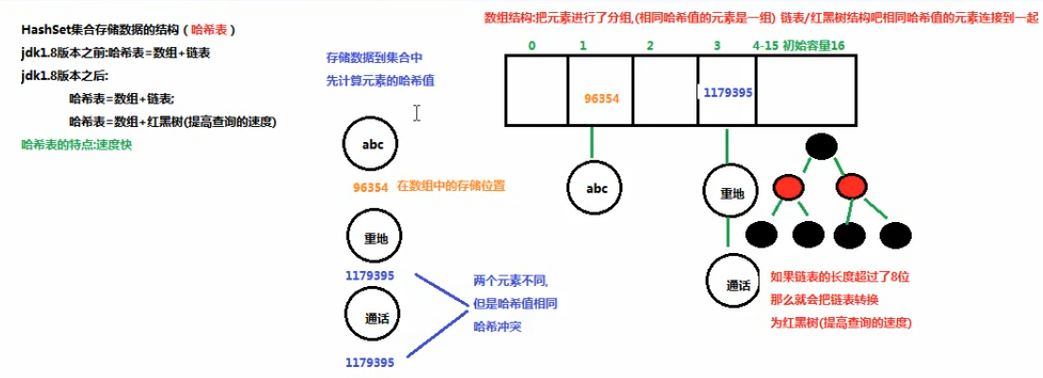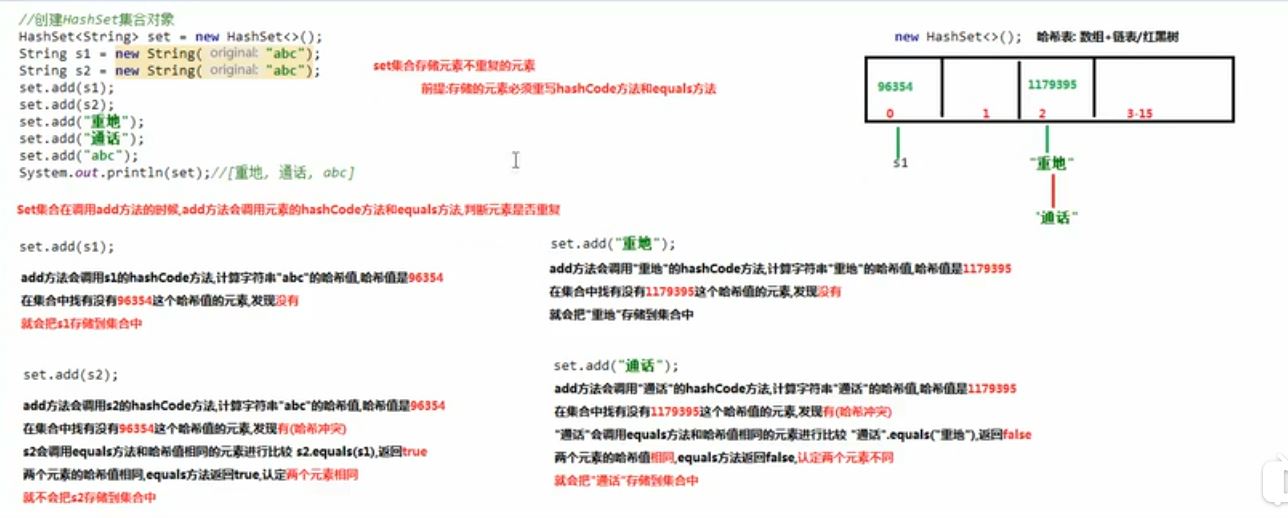Set集合接口、HashSet集合、LinkedHashSet集合、可变参数
Set接口
java.util.Set接口 extends Collection
Set接口的特点:
1.不能出现重复的元素
2.没有索引,没有带索引的方法,也不能使用普通的for循环遍历
里面包含的方法和Collection里面的方法差不多
java.util.HashSet集合implements Set接口
HashSet特点:
1.不允许出现重复的元素
2.没有索引,没有带索引的方法,也不能使用普通的for循环遍历
3.是一个无序集合,存储元素和取出元素的顺序可能不一致
4.底层是一个哈希表结构(查询的速度非常快)
package mycollection;
import java.util.HashSet;
import java.util.Set;
public class TestHashSet01 {
public static void main(String[] args) {
Set<Integer> set = new HashSet<>();
set.add(1);
set.add(3);
set.add(2);
set.add(1);
for (Integer i : set) {
System.out.print(i+"\t");//1 2 3
}
}
}
哈希值
哈希值:是一个十进制的整数,由系统随机给出(就是对象的地址值,是一个逻辑值,是一个模拟出来得到的地址,不是数据实际存储的物理地址)
在object类中有一个方法,可以获取对象的哈希值
public native int hashCode();
native:代表调用本地系统的操作方法
package mycollection;
public class TestHashCode01 {
public static void main(String[] args) {
Person p1 = new Person();
System.out.println(p1.hashCode());//460141958
Person p2 = new Person();
System.out.println(p2.hashCode());//1163157884
/*toString的源码:
* return getClass().getName() + "@" + Integer.toHexString(hashCode());(后面将哈希码转化为十六进制)*/
System.out.println(p1);//mycollection.Person@1b6d3586 后面数字1b6d3586是460141958的十六进制表达
System.out.println(p2);//mycollection.Person@4554617c
/*string类的哈希值
* string类重写了继承object类的hashCode()方法*/
String str1 = new String("abc");
String str2 = new String("abc");
System.out.println(str1.hashCode());//96354
System.out.println(str2.hashCode());//96354 字符串相同,两者哈希码相同
//巧合,字符串不一样,哈希码一样
System.out.println("重地".hashCode());//1179395
System.out.println("通话".hashCode());//1179395
}
}
class Person{
//从object类中继承来的hashCode()方法可以重写
/*@Override
public int hashCode() {
return 1;
}*/
}
HashSet的存储数据的结构:哈希表结构

HashSet集合存储不重复的元素的原理:
前提:存储的元素必须重写hashCode方法和equals方法

HashSet存储自定义类型元素
set集合保存的元素唯一:
存储的元素(string,integer,....Student,Person),必须重写hashCode方法和equals方法
当存储的元素没重写hashCode方法和equals方法时:
package mycollection;
import java.util.HashSet;
//HashSet存储自定义类型元素
//set集合不允许存储相同姓名和年龄的学生
public class TestHashSet02 {
public static void main(String[] args) {
HashSet<Student> set = new HashSet<>();
Student s1 = new Student("小明",12);
Student s2 = new Student("小化",13);
Student s3 = new Student("小明",12);
set.add(s1);
set.add(s2);
set.add(s3);
System.out.println(set);
System.out.println(s1.hashCode());//460141958
System.out.println(s3.hashCode());//1956725890
System.out.println(s1.equals(s3));//false
System.out.println(set);//[Student{name='小明', age=12}, Student{name='小化', age=13}, Student{name='小明', age=12}]set中存储了相同的学生
}
}
class Student{
private String name;
private int age;
public Student() {
}
public Student(String name, int age) {
this.name = name;
this.age = age;
}
public String getName() {
return name;
}
public void setName(String name) {
this.name = name;
}
public int getAge() {
return age;
}
public void setAge(int age) {
this.age = age;
}
@Override
public String toString() {
return "Student{" +
"name='" + name + '\'' +
", age=" + age +
'}';
}
}
当存储的元素重写hashCode方法和equals方法时:
package mycollection;
import java.util.HashSet;
import java.util.Objects;
//HashSet存储自定义类型元素
//set集合不允许存储相同姓名和年龄的学生
public class TestHashSet02 {
public static void main(String[] args) {
HashSet<Student> set = new HashSet<>();
Student s1 = new Student("小明",12);
Student s2 = new Student("小化",13);
Student s3 = new Student("小明",12);
set.add(s1);
set.add(s2);
set.add(s3);
System.out.println(set);
System.out.println(s1.hashCode());//23458766
System.out.println(s3.hashCode());//23458766
System.out.println(s1.equals(s3));//true
System.out.println(set);//[Student{name='小化', age=13}, Student{name='小明', age=12}],没有重复的学生
}
}
class Student{
private String name;
private int age;
public Student() {
}
public Student(String name, int age) {
this.name = name;
this.age = age;
}
//重写了hashCode方法和equals方法
@Override
public boolean equals(Object o) {
if (this == o) return true;
if (o == null || getClass() != o.getClass()) return false;
Student student = (Student) o;
return age == student.age &&
Objects.equals(name, student.name);
}
@Override
public int hashCode() {
return Objects.hash(name, age);
}
public String getName() {
return name;
}
public void setName(String name) {
this.name = name;
}
public int getAge() {
return age;
}
public void setAge(int age) {
this.age = age;
}
@Override
public String toString() {
return "Student{" +
"name='" + name + '\'' +
", age=" + age +
'}';
}
}
LinkedHashSet集合
java.util.LinkedHashSet集合 extends HashSet集合
LinkedHashSet集合特点:
底层是一个哈希表(数组+链表/红黑树)+链表:多了一条链表(记录元素的存储顺序),保证元素有序
package mycollection;import java.util.HashSet;
import java.util.LinkedHashSet;public class TestLinkedHashSet01 {
public static void main(String[] args) {
HashSet<String> set = new HashSet<>();
set.add("abc");
set.add("abc");
set.add("哈哈哈哈");
set.add("哦哦哦");
System.out.println(set);//[哈哈哈哈, abc, 哦哦哦] 不允许重复 无序LinkedHashSet<String> linked = new LinkedHashSet<>(); linked.add("abc"); linked.add("abc"); linked.add("哈哈哈哈"); linked.add("哦哦哦"); System.out.println(linked);//[abc, 哈哈哈哈, 哦哦哦],不允许重复 有序,按添加顺序 }
}
可变参数:是jdk1.5之后出现的新特性
使用前提:
参数列表的数据类型已经确定,但参数个数不确定,就可以使用可变参数
使用格式:方法定义时使用
修饰符 返回值类型 方法名(数据类型... 变量名){}
可变参数的原理:
可变参数的底层就是一个数组,根据传递参数的个数不同,会创建不同长度的数组,来存储这些参数
传递的参数个数,可以是0个(不传递),1,2...多个
注意事项:
1.一个方法的参数列表,只能有一个可变参数
2.如果方法的参数有多个,那可变参数必须在参数列表末尾
public int add(int... arr){ int sum = 0; for (int i : arr) { sum += i; } return sum; } public void add2(double d,float f,int...arr){}
**可变参数的终极写法**
public void method(Object... objects){//可以接受任意数据类型
}



